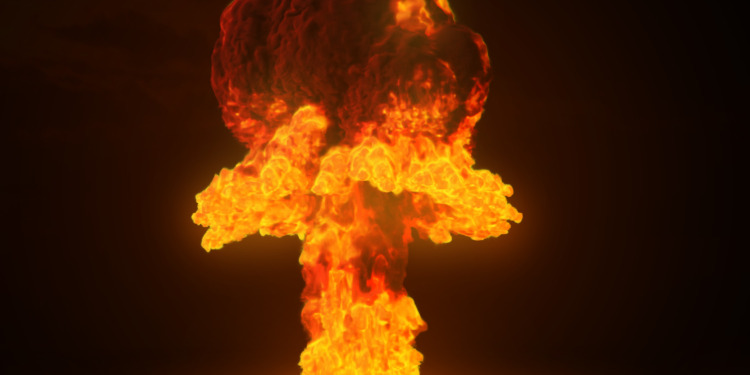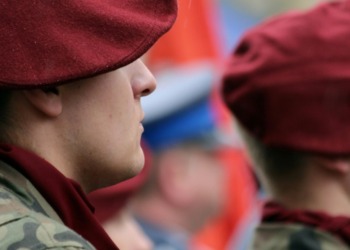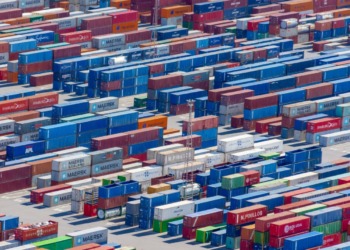Putin’s threat of placing missiles with nuclear heads in Belarus “in the coming months” came last week, just before the G7 Summit: The timing is not casual but deliberate, as I pointed out in an earlier article. It’s a clear message to the West that Putin means business and intends to win this war, no matter what. Regardless of the human cost.
Let’s clear up one point immediately: Given the massive amount of nuclear armaments around the world, a full-scale nuclear war is “unthinkable” in the sense that if you think it through, the whole planet blows up and nothing remains: That’s the theory of “mutually-assured destruction”. What we are talking about here – and what Putin is threatening – are limited nuclear blasts, say on one city. But experts have worked out, taking the example of Rotterdam, that even a limited nuclear attack would immediately kill 8,000 people while others suffer severe burns, and most likely twice that number of people would face lasting health consequences, including cancer. And medical services cannot be allowed in to help people:
Note in the above video the Pentagon’s “war games” that were run in 2020 positing a Russian nuclear attack and a US response: The conclusion was that the most appropriate response would be a recourse to conventional (non-nuclear) arms.
As of now, there is only one treaty regulating Russian and American nuclear arsenals, the New START (Strategic Arms Reduction Treaty) signed in 2010 between President Obama and Putin, calling for regular verification that was paused due to Covid. Whether it can resume in the current situation is open to question: The war is clearly a setback for nuclear arms control.
Then on a more immediate level, as AP reported yesterday with the telling title “Russia’s messages with missiles tell West to back off”, came the bombing of a busy shopping mall in the daytime, 500 km inside Ukraine and far from the front lines of a war now in its fifth month and that night, Kyiv was hit too.
As expected, Putin denied aiming at civilians saying the objective was a nearby weapons depot. But Ukrainian officials and witnesses saw a missile directly hit the mall. And at least six people were killed in the Kyiv strike, which destroyed an apartment building.
In this case too, as the AP reporters noted, “the timing was not likely a coincidence. […it] unfolded in full view of the world and especially of Western leaders gathered for a trio of summits in Europe.” The “summits” in question, the G7, and NATO meetings involved U.S. President Joe Biden, British Prime Minister Boris Johnson, German Chancellor Olaf Scholz, and French President Emmanuel Macron, all supporters of Ukraine.
And this is not the first time Putin does it. We all remember when U.N. Secretary-General Antonio Guterres visited Ukraine in late April, Russian missiles struck Kyiv barely an hour after Zelensky held a news conference.
Putin has, again and again, repeated warnings that Moscow would strike targets it had so far spared – meaning what? Towns in Europe? – if the West supplied Ukraine with weapons that could reach Russia. Most recently, he said that if Ukraine gets long-range rockets, Russia will “draw appropriate conclusions and use our means of destruction, which we have plenty of,” he said.
And he never stops. On Friday, July 1, a day after Russian forces unexpectedly retreated from Snake Island near the Black Sea port city of Odesa following what Ukraine called a barrage of artillery and missile strikes, Russia bombarded residential areas in a coastal town near Odesa killingat least 21 people, including two children.
Putin is indeed sending strong messages to the West as Kyiv Mayor Vitali Klitschko put it after the Kyiv bombing, saying this “maybe [construed as] a symbolic attack” just as the G7 and NATO were busy applying further pressure on Moscow. The mayor’s point was, of course, that it should concern the whole of Europe.
And that is something Ukraine President Zelensky never fails to do: In this case too, he was quick to describe the mall attack as “one of the most daring terrorist attacks in European history.” Arguably, not the worst act of terrorism on civilians, considering, for example, the 137 dead in the Paris 2015 terrorist attacks – but nobody can deny Ukraine’s indisputable suffering.
And nobody can deny Russia is acting as a terrorist state, with the most cavalier disregard for the Geneva conventions or even the most basic rules of warfare. Unsurprisingly, accusations of genocide are piling up, the investigations into Russian war crimes promise to become the largest in History.
For some reason, both the West and NATO continue to misread the war in Ukraine: Our political leaders refuse to see that it’s not just Ukraine that is threatened but the whole of Europe and the free world.
That may be a tired cliché but it means you and me.
It’s fine and good that the G7, at their meeting, solemnly stated that they stand behind Ukraine. Nice strong words that we all support and yes, accompanied by generous pledges to send more arms and equipment, to help rebuild Ukraine, to work on ensuring Ukrainian grain is exported to avoid a world food crisis, to support Ukrainian refugees, to tighten the sanctions against Russia even though sanctions boomerang and rarely achieve intended results, or at best, only partly so. But that’s another matter I won’t get into here, I already covered that issue in a previous article, arguing that more or better, even well-coordinated sanctions are not the answer.
Setting the sanctions issue aside for the moment, is this then all to the good? No, because the West’s main armament in its arsenal is frozen: It makes no sense for NATO to hide behind Article 5 which requires – according to a strict interpretation of it – that a member of the alliance needs to be directly attacked before the alliance can move.
Military observers tend to read Putin’s messages better: “The Russians are humiliating the leaders of the West,” said the former commanding general of U.S. Army forces in Europe, retired Lt. Gen. Ben Hodges.
But it’s not a point of honor or a question of humiliation. It’s much more than that. What will it take to make NATO move?
A Russian bomb falling on the soil of a NATO member?
When will NATO wake up and realize that Putin’s war on Ukraine is a war on all the democracies in Europe and anywhere in the world and comes right under Article 5, enabling it to unleash its full power?
True, NATO hasn’t been idle.
At its latest meeting, it agreed to the biggest upgrade of its military presence in Europe since the end of the Cold War, raising the number of troops “on high alert” to more than 300,000 and strengthening European forces, as well as adding China to Russia, labeling both “long term security concerns”, and formally inviting Sweden and Finland to join. Once they’ve joined, NATO will be close to a near-total overlap with the EU, leaving out only four states, Ireland, Austria, Malta and Cyprus.
As to its defense systems, for logistical reasons, it will take time to reach the 300,000 troops goal. For now, the US is still its leading power as the EU hasn’t yet come to grips with building its own European defense system (even though it is now spending more on defense than it ever has).
But, despite the strengthening of NATO and European forces, I will argue here that a red line needs to be drawn and that red line is a Russian nuclear attack on Ukraine, even a limited one. But this needs to be officially declared by the West, and therefore NATO must issue a statement clearly indicating so – otherwise Putin will not understand.
It’s in his interest not to understand and to continue to threaten us. After all, so far, there have been no consequences. He took Crimea in 2014 and nobody budged. He allowed a simmering war in the Donbas, and nobody budged. Now he’s attacking Ukraine, and still, nobody budges. Yet even he can’t control nuclear fallout.
What is the difference between a bomb falling on the soil of a NATO member and a nuclear cloud drifting across the border into Europe?
We all know that nuclear fallout from a bomb knows no borders: We have all seen how the cloud formed by the Chernobyl reactor blow-up in Ukraine, pushed by the wind, ended covering the whole of Europe in 1986. Ten years later, many European citizens who were not Ukrainians, who lived far away in the Baltic states and other places, got sick with cancer and other degenerative diseases.
Are we going to let Putin get away with war and murder just because Article 5 says the attack has to take place on the soil of a NATO member state?
Yet, if and when a nuclear cloud, pushed by the wind, crosses the Ukraine border, it is, concretely, a Russian attack on that NATO-protected soil.
Are we really going to wait for that to happen and then start a war in retaliation? Is that even a reasonable response to consider? Or (what is more likely given our political leaders’ lack of determination) will we just sit back and do nothing while Putin ravages Europe, turning Ukraine into a desert and engulfing the rest of Europe in a nuclear, cancer-producing cloud?
But set aside this possibility for a moment and consider Putin’s nuclear threats in a broader context. After all, we might get lucky and the wind could push back the nuclear cloud toward Russia…
So why should we react to Putin’s threats anyway? Isn’t President Biden right in ignoring them? That’s what he has done so far and now so has NATO at its recent meeting: Biden simply ignored Putin’s pronouncements the first time he made them, back in March, and there’s an argument going around that this is the right answer. I beg to disagree, because a lot more than a possible nuclear fallout is at stake.
What is at stake in the Russian aggression on Ukraine: Our democracy, our way of life
Let’s ask the basic question that should have been asked from the start of the Ukraine war and even earlier when he annexed Crimea: What is Putin’s end-game?
What we have here is an autocratic country on the borders of Europe: Russia, with an enclave inside Europe, Kaliningrad. Putin’s Russia has attacked, unprovoked, a neighboring country, Ukraine, a free and working democracy. There can be no doubt that it is out to destroy liberal democracies across Europe, starting with Ukraine but not likely to stop there. Lithuania or Romania or Moldova could be next. Putin’s personal grip on power depends on it.
We need to remember that Putin is a shameless dictator who has jailed Alexei Navalny, the only serious political opponent he had, giving him an 11-12 year jail sentence and sending him to an unknown location, possibly a penal colony further east at Melekhovo near Vladimir, about 250 km (155 miles) from Moscow.
Meanwhile, Putin’s pretext for invading Ukraine borders on the absurd and ridiculous: This is not a war, Putin argues, but a “military operation to denazify the country” – whoever said Ukraine was in the hands of Nazis? And he means to oust Zelensky, its democratically-elected President. Any Russian citizen who dares to disagree is sent to prison for up to 15 years.
What kind of regime is that? Unabashedly authoritarian, with one sole purpose: to attack and demolish democracy everywhere. Moreover, it does so at a horrendous cost in human lives. Its principal military strategy is to target civilians, raining missiles on civilian buildings, hospitals, schools, theaters, and shopping centers, creating a desert to allow its tanks to move in, and terrorizing the population into submission.
Because Putin is a dictator, it means his very survival in power depends on suppressing any desire for freedom: Democratic systems everywhere are his enemies. By attacking Ukraine, he figured he’d kill two birds with one stone: He’d stop NATO’s eastward expansion and turn Ukraine into a vassal state.
The cherry on the cake: Kick out Zelensky, the Jewish comedian-turned-politician that he abhors and replace him with one of his favorite buddies, most likely Viktor Yanukovych who was moved out of office with a Parliament vote, as a result of the Ukrainian 2014 revolution. Indeed, there were reports at the start of the war that he had sent Yanukovych to Belarus, waiting to cross the border since Kyiv was expected to fall right away as Crimea had.
Kyiv didn’t fall and Ukraine’s resistance surprised Putin and even forced him to retreat and concentrate his efforts on the Donbas. But that doesn’t mean he will give up. For now, he is slowly gaining ground in Eastern Ukraine (even if he’s had to give up Snake Island) and with missile strikes like the recent ones on the shopping mall and on Odesa, he reminds everyone he won’t stop.
So NATO needs to remember why it was set up in the first place: In 1949, as a military alliance to provide collective security against the Soviet Union. How did it happen?
Let us briefly recall the context. NATO arose as the result of a series of events in 1947-48 that caused the nations of Western Europe to become concerned about their physical and political security and the United States to become more closely involved with European affairs. The ongoing civil war in Greece, along with tensions in Turkey, led President Harry S. Truman to assert that the United States would provide economic and military aid to both countries, as well as to any other nation struggling against an attempt at subjugation. (bolding added)
Stop and note: Isn’t that precisely what Russia is engaged in now, subjugation of a European nation, Ukraine?
There were other causes for concern at the time, such as the communist drift in Italy and the power coup in Czechoslovakia that resulted in a communist government. In mid-1948, Soviet premier Joseph Stalin chose to test the West by implementing a blockade against West Berlin, which was then under joint U.S., British, and French control but surrounded by Soviet-controlled East Germany. This Berlin Crisis brought the United States and the Soviet Union to the brink of war, although a massive airlift to resupply the city for the duration of the blockade helped to prevent it
In all this, five European countries, Great Britain, France, Belgium, the Netherlands, and Luxembourg, got together and in March 1948 signed the Brussels Treaty to address their growing security concerns. Two months later, the US Congress moved, passing the Vandenburg Resolution formulated by a Republican Senator that proposed the President seek a security treaty with Western Europe that would adhere to the United Nations charter but exist outside of the Security Council where the Soviet Union held veto power.
At that point, negotiations began for NATO. They were long and arduous and ended with the famous collective defense agreement encapsulated in Article 5, whereby an attack on one was an attack on all. But, historically, the main role played by NATO in the Cold War was this:
“The collective defense arrangements in NATO served to place the whole of Western Europe under the American “nuclear umbrella.” In the 1950s, one of the first military doctrines of NATO emerged in the form of “massive retaliation,” or the idea that if any member was attacked, the United States would respond with a large-scale nuclear attack. The threat of this form of response was meant to serve as a deterrent against Soviet aggression on the continent.” (bolding added)
Since 1989, with the fall of the Soviet Union and the end of the Cold War, NATO, far from disappearing, has expanded its presence around the world, engaging everywhere in peace and security operations, as its own video produced in 2020 explains:
Finally, consider the opening paragraph of the NATO treaty:
The Parties to this Treaty reaffirm their faith in the purposes and principles of the Charter of the United Nations and their desire to live in peace with all peoples and all governments.
They are determined to safeguard the freedom, common heritage and civilisation of their peoples, founded on the principles of democracy, individual liberty and the rule of law. They seek to promote stability and well-being in the North Atlantic area.
Yes, the purpose of NATO is to “safeguard the freedom…founded on the principles of democracy, individual liberty and the rule of law”. Strong words that ring clear and there is no doubt that Russia is a threat to freedom and the “stability and well-being in the North Atlantic Area”, Article 5 notwithstanding.
And now it appears the lessons of History are lost on everyone except Putin who seems to be the only one who remembers how to use the nuclear threat of war as a deterrent – and this time, against the West.
It’s high time to draw a red line and tell him that even a limited nuclear attack will elicit a “mirrored response” – to use Putin’s own language. And as we have seen, limited nuclear blasts are just as devastating as a full war.
But let me be clear: I’m not advocating war here, on the contrary. I firmly believe that drawing such a red line is needed to avoid the worst consequences of war – in this case, an expansion of war across Europe. Just like the “nuclear deterrent” worked to avoid any nuclear conflict during the entire Cold War, so would a red line, as advocated here.
Editor’s Note: The opinions expressed here by Impakter.com columnists are their own, not those of Impakter.com — Featured Photo: Nuclear explosion Photo credit: George Hodan CCO










